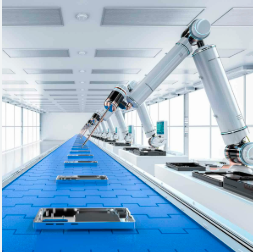What is a Cobot

As automation becomes more integrated into various industries, many people are asking, What is a cobot, and how does it differ from traditional robots. A cobot, short for collaborative robot, is designed to work safely alongside humans, assisting with tasks that require precision, consistency, or repetitive motion.
Unlike conventional industrial robots that operate in isolated areas, cobots can share workspace with human operators without the need for heavy safety barriers. In this guide, we will explain what a cobot is, how it works, and why it is becoming an essential tool in modern manufacturing and beyond.
What is a Cobot?
A cobot, or collaborative robot, is a robot designed to work safely alongside humans in the same workspace. Unlike traditional industrial robots, which usually work alone behind safety barriers, cobots have sensors, cameras, and safety features that help them detect people and avoid accidents.
Cobots are flexible and easy to program, so they can do many tasks like assembly, inspection, packaging, or welding. They work with humans instead of replacing them, helping increase productivity, reduce mistakes, and adapt to changing work needs. Cobots are safe, accurate, and adaptable, making them useful for any business using automation.
Key Features of Cobots
- Safety-Focused: Cobots have sensors and force-limiting technology to detect humans and prevent injuries.
- Easy to Integrate: Compact size and user-friendly controls make it simple to add cobots to existing workflows.
- Versatile: They can handle tasks like assembly, welding, packaging, and quality inspection across industries such as automotive, electronics, and consumer goods.
- Collaborative: Cobots perform repetitive or physically demanding tasks, allowing humans to focus on complex, value-added work.
Cobots combine human expertise with robotic efficiency, making work safer, faster, and more flexible.
How Cobots Work
Cobots (collaborative robots) are built to work safely with humans. Here’s how they operate:
- Smart Sensors & Safety
Cobots are equipped with sensors such as force detectors, cameras, and proximity systems to detect people or objects nearby. If something gets too close, they slow down, stop, or reduce force to prevent accidents. Built-in power and force limits make them safe to touch.
- Flexible Arm Movement
Cobot arms typically have 4–7 joints, allowing them to move like a human arm. This gives them precision, flexibility, and the ability to work in tight spaces. Their lightweight design also makes them easy to move around the workspace as needed.
- Easy Programming
Cobots are user-friendly and don’t require coding skills. You can teach them tasks by guiding their arm by hand, or program them using simple touchscreen or drag-and-drop software.
- Core Parts
- Robotic Arm → does the physical movement.
- Controller → the “brain,” managing motion and safety.
- End-Effector → the tool at the tip (gripper, welder, suction cup, etc.), which changes depending on the job.
- Vision Systems (Optional)
Some cobots have cameras or LiDAR to recognize objects, read barcodes, or adjust automatically if parts are in different positions.
- Safe Human Collaboration
Cobots are designed to work safely alongside humans without the need for protective cages. They operate at slower speeds, feature rounded edges, and comply with safety standards to prevent accidents.
- Quick Setup & Adaptability
Cobots are compact and easy to program, allowing them to be added to existing workflows quickly. They can also be reprogrammed to switch between tasks, making them ideal for factories with changing production needs.
Cobots combine human creativity with robotic precision. They are safe, easy to use, flexible, and cost-effective, making automation accessible not only for large factories but also for small and big businesses.
Advantages of Cobots
- Enhanced Safety & Human Collaboration
Cobots are designed to work safely with people. They have sensors, force limits, and emergency stop features, so they usually don’t need cages or barriers. By handling repetitive or risky jobs, they also reduce workplace injuries.
- Improved Flexibility & Ease of Use
Cobots are small, portable, and easy to set up. They can be programmed using simple tools or by guiding them manually, with no coding required. They can also be quickly reprogrammed to perform different tasks such as welding, inspection, or packaging.
- Boosted Productivity & Precision
Cobots don’t get tired like humans. They can work continuously at the same speed and accuracy, which reduces mistakes and ensures consistent product quality.
- Cost Efficiency & Lower Barriers to Automation
Cobots are generally less expensive than traditional industrial robots and don’t need costly safety cages. They are easy to set up and use, so businesses can see a quick return on investment. They also help save money by reducing waste, maintenance, and labor costs.
- Enhanced Employee Engagement & Satisfaction
Cobots handle boring, dirty, or dangerous tasks, letting workers focus on more important and creative work. This helps improve morale and job satisfaction.
- Scalability & Future-Ready Operations
Cobots can be quickly integrated or reprogrammed to meet growing production demands, making them an ideal solution for businesses seeking flexible, scalable, and future-ready automation.
Cobots bring together safety, flexibility, productivity, cost savings, and scalability, making automation accessible to businesses of all sizes.
Differences Between Cobots and Traditional Robots
- Human Interaction & Safety
- Cobots: Built to work side by side with people. They have safety features like force sensors and auto-stop, so they don’t need safety cages.
- Industrial Robots: Very powerful and fast, but dangerous to humans. They must be placed in fenced-off areas.
- Size & Workplace Flexibility
- Cobots: Small, lightweight, and easy to move. Ideal for flexible setups or tasks that frequently change.
- Industrial Robots: Large and fixed in place. Best for stable, high-volume production lines.
- Programming & Deployment
- Cobots: Simple to program with drag-and-drop tools or hand-guiding (“teach mode”). Even non-experts can set them up quickly.
- Industrial Robots: Require expert programmers and longer setup times. Integration is more complex.
- Cost & ROI
- Cobots: Lower upfront cost, minimal safety equipment needed, and often pay for themselves within a year.
- Industrial Robots: High investment in hardware and safety systems, but worth it for large-scale, repetitive production.
- Performance & Precision
- Cobots: Flexible and adaptable, but slower and less powerful.
- Industrial Robots: Extremely fast, precise, and strong, ideal for heavy-duty or continuous tasks.
- Ideal Use Cases
- Cobots: Perfect for small-batch jobs, frequent changes, and human-robot teamwork.
- Industrial Robots: Best for high-volume, repetitive, and precision-driven manufacturing.
Conclusion
Cobots, or collaborative robots, are built to work safely with humans, combining the robot’s accuracy with human skills. Unlike normal industrial robots, cobots don’t need safety cages and can work safely next to people, so they are good for both small and large businesses.
With smart sensors, flexible arms, easy programming, and quick setup, cobots can easily adjust to changing tasks. They make work safer, help get more done, reduce mistakes, and save money by doing repetitive, dangerous, or boring jobs.
Cobots also let employees focus on more important and creative work, which improves job satisfaction. Their flexibility, ability to grow with the business, and low cost make them a smart, future-ready solution. In short, cobots make automation safe, simple, and useful, helping humans and robots work together better.





